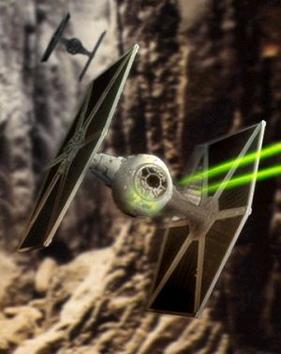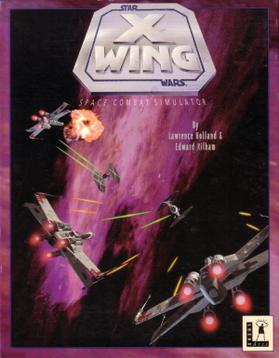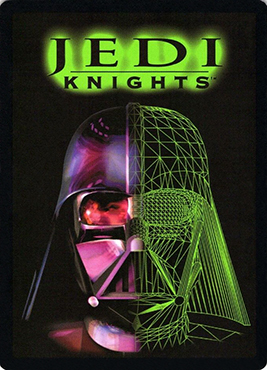
The TIE fighter or Twin Ion Engine fighter is a series of fictional starfighters featured in the Star Wars universe. TIE fighters are depicted as fast, agile, yet fragile starfighters produced by Sienar Fleet Systems for the Galactic Empire and by Sienar-Jaemus Fleet Systems for the First Order and the Sith Eternal. TIE fighters and other TIE craft appear in Star Wars films, television shows, and throughout the Star Wars expanded universe. Several TIE fighter replicas and toys, as well as a TIE flight simulator, have been produced and sold by many companies.

The X-wing starfighter is a name applied to a family of fictional spacecraft manufactured by the Incom Corporation and later the Incom-FreiTek Corporation from the Star Wars franchise. Named for the distinctive shape made when its s-foils (wings) are in attack position, the X-wing was a class of starfighter used by the Rebel Alliance in their conflict with the Galactic Empire. It made its theatrical debut, as the T-65B model, in Star Wars (1977) as the spacecraft piloted by Luke Skywalker and the Red Squadron when Luke destroyed the Death Star. The starfighter featured extensively in the Star Wars original trilogy and in the Expanded Universe that followed, and has been merchandised as a variety of toys and models.

Kuat RZ-1 A-wing Interceptor are starfighters in the Star Wars franchise. Designed and manufactured by the Kuat Systems Engineering, they are depicted as fast but fragile interceptors of the Rebel Alliance, conceived for high-speed surgical strikes, deep reconnaissance and escort fighter duty.
Star Wars: Customizable Card Game (SW:CCG) is an out-of-print customizable card game based on the Star Wars fictional universe. It was created by Decipher, Inc., which also produced the Star Trek Customizable Card Game and The Lord of the Rings Trading Card Game. The game was produced from December 1995 until December 2001. Since 2002, the game has been maintained by the Star Wars CCG Players Committee, with new virtual cards being released every few months and the capability to play both in person and online.

Star Wars Galaxies was a Star Wars- themed massively multiplayer online role-playing game (MMORPG) for Microsoft Windows, developed by Sony Online Entertainment and published by LucasArts.
NECA/WizKids, LLC is an American company based in New Jersey that produces tabletop games. WizKids is best known for its collectible miniatures games (CMGs) Mage Knight, HeroClix, MechWarrior, and HorrorClix, all of which make use of the company's Clix system, in which the changing combat statistics and abilities of each figure were indicated by a turnable dial inside the base underneath the figure. The company was founded in 2000 by Jordan Weisman, a veteran of the game company FASA. It was purchased by sports-card manufacturer Topps, Inc. in 2003.

Star Wars: The Trading Card Game is an out-of-print collectible card game produced by Wizards of the Coast (WotC). The original game was created by game designer Richard Garfield, the creator of the first modern trading card game, Magic: The Gathering. After its initial release in April 2002, the game was 'put on indefinite hold' by WotC in late 2005. The Star Wars Trading Card Game Independent Development Committee was created by a group of fans to continue development of the game. They design new cards that are available as free downloads at their website.

Star Wars: Galactic Battlegrounds is a real-time strategy video game set in the Star Wars universe. It was developed by LucasArts. It was released in November 2001. An expansion pack, Clone Campaigns, was released on May 14, 2002, adding two new factions and campaigns. Later that year, both Galactic Battlegrounds and Clone Campaigns were released in a box set, Star Wars: Galactic Battlegrounds Saga.
MechWarrior: Dark Age was a tabletop wargame by WizKids set in the BattleTech universe that uses the Clix system. The game's miniatures are pre-painted models of infantry squads, vehicles, and giant walking war machines known as BattleMechs or more simply "'mechs".

Over one hundred video games based on the Star Wars franchise have been released, dating back to some of the earliest home consoles. Some are based directly on films while others rely heavily on the Star Wars Expanded Universe.

Star Wars: X-Wing is a space simulation video game, the first of the X-Wing combat flight simulation games series. The player's character flies starfighters, including the X-wing, for the Rebel Alliance. The narrative precedes and parallels the events of Star Wars Episode IV: A New Hope.

Star Wars: Starfighter is a 2001 action video game, developed and published by LucasArts, that takes place right before the Battle of Naboo. The player unites alongside three starfighter pilots and is allowed to take control of several different spacecraft to help stop the invasion that threatens Naboo.

Star Wars: TIE Fighter is a 1994 Star Wars space flight simulator and space combat video game, a sequel in the Star Wars: X-Wing series. It places the player in the role of an Imperial starfighter pilot during events that occur between The Empire Strikes Back and Return of the Jedi.

Jedi Knights Trading Card Game is an out-of-print collectible card game set in the Star Wars Universe and published by Decipher, Inc. on April 25, 2001. Two expansion packs, titled Scum and Villainy and Masters of the Force, were produced before the end of 2001. Shortly after their release, Decipher lost the license to utilize material from the Star Wars franchise and was forced to discontinue the game.

Clone Wars Adventures was an online virtual world based on the animated television series Star Wars: The Clone Wars. Players could create and customize in-world avatars and participate in a variety of Clone Wars-themed mini-games and activities, earning Republic credits to purchase new weapons, outfits, ships, and furniture. Clone Wars Adventures was free to download and play, but only those that had a paid membership got access to a majority of the game's features. Additionally, many outfits and premium items could only be purchased with Station Cash, a form of in game currency that players needed to purchase with real money instead of in-game credits. This massively multiplayer online game follows a similar business model to Free Realms. However, unlike Free Realms, the game was released at retail, though the game is free-to-play.
Star Wars: X-Wing is a series of space flight simulator video games based in the Star Wars media franchise that attempts to simulate the fictional experience of starfighter combat, while remaining faithful to the movies. The player took the role of a pilot of the Rebel Alliance, and, in later games, the Galactic Empire. To complete the games, players must complete missions such as simple dogfights with opposition starfighters, reconnaissance and inspection tasks, escort duty for freighters or capital ships, or attacks on larger opposition ships. In addition to dogfighting designed to resemble the free-wheeling duels of World War I, the games also offered the challenge of managing power resources and wingmen, and using weapons effectively.
Star Wars: The Card Game is a Living Card Game (LCG) produced by Fantasy Flight Games. It is a two-player card game set in the Star Wars universe. It puts one player in command of the light side of the Force, and one player in command of the dark side of the Force. The Balance of the Force expansion allows multi-player games. The game is set within the time-frame of the original Star Wars trilogy.
Star Wars: X-Wing Second Edition is the second edition of the miniature war game designed by Jay Little and produced by Fantasy Flight Games that was first announced on May 1, 2018, with the first release on September 13 of the same year. On November 16, 2020, Atomic Mass Games announced that it would be responsible for X-wing and its two sister games, Legion and Armada.











